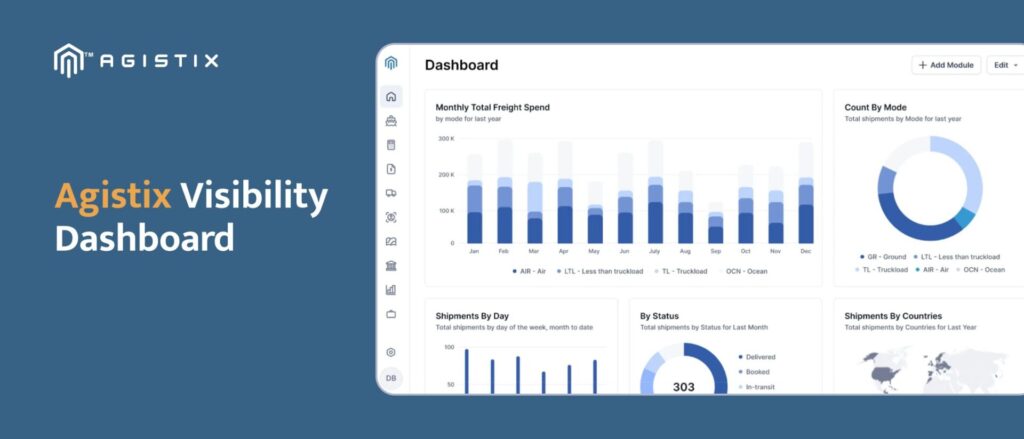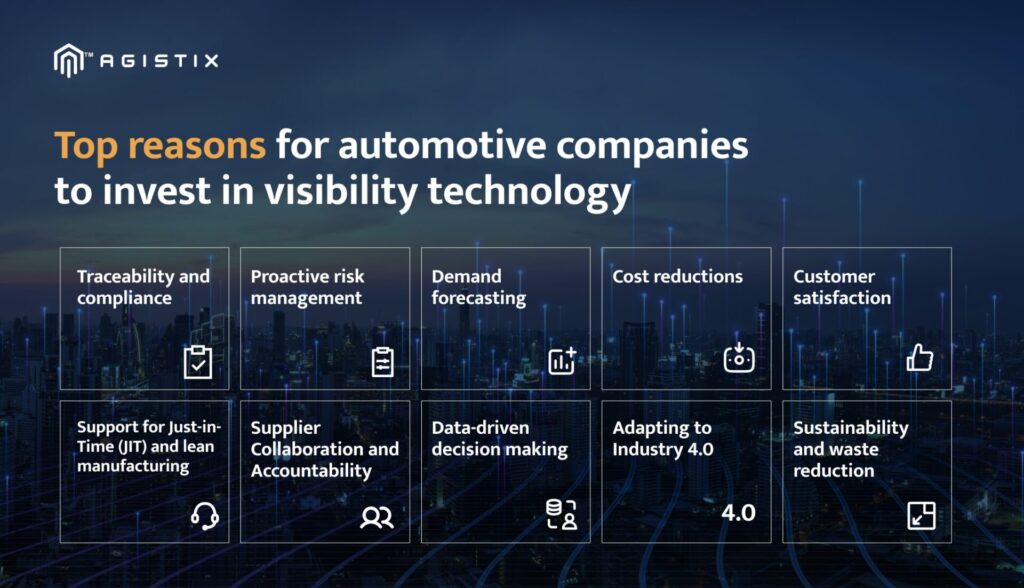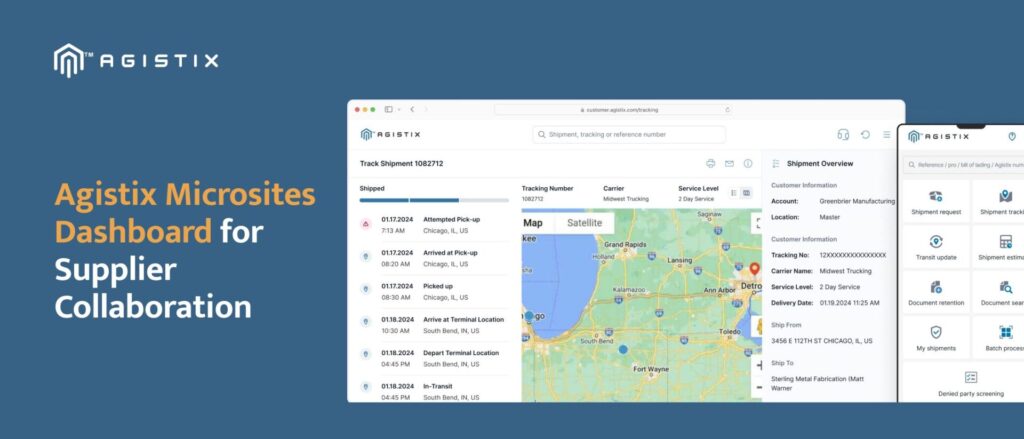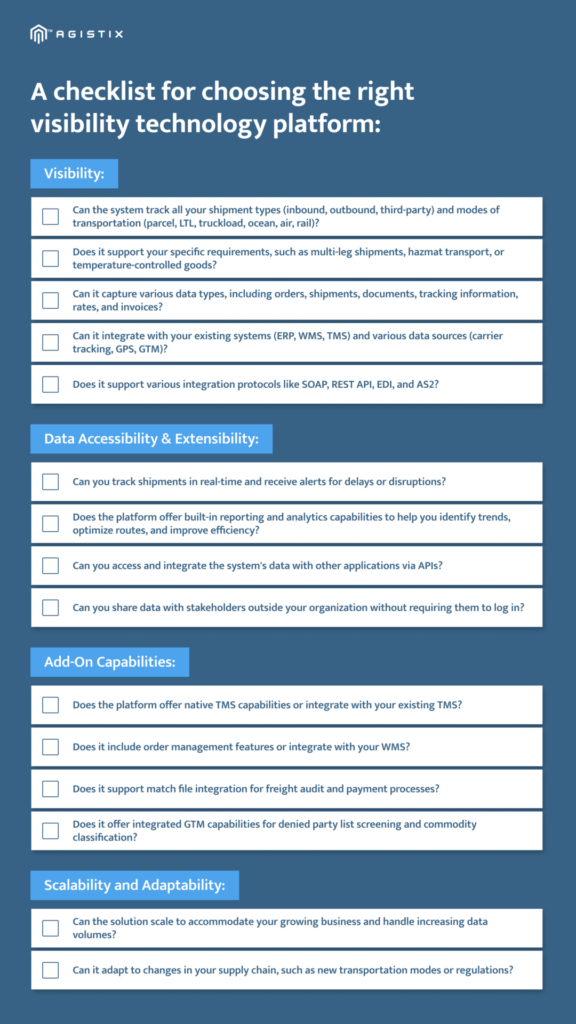January 23, 2025 - 9 minutes read

10 Reasons Automotive Supply Chains Should Invest in Visibility Technology
At first glance, you might assume that automotive giants have mastered supply chain efficiency. In reality, the industry is grappling with significant challenges, including macroeconomic volatility, geopolitical tensions, sourcing issues, and mounting sustainability demands. This constant state of flux has left many industry players feeling overwhelmed and uncertain, forcing them to react quickly, but often without a cohesive long-term strategy. Simply centralizing the supply chain is a step in the right direction, but it is just one piece of the larger, complex puzzle.
To thrive in this turbulent environment, automotive companies need a more holistic and adaptable approach to supply chain management. This requires a strategic framework that extends to include numerous external factors, internal capabilities, and operational priorities.
In light of this, visibility technology has emerged as an essential resource for automotive companies to improve transparency, control, and efficiency within their supply chains.
Current challenges in automotive supply chains
The automotive industry faces unique challenges that threaten supply chain stability. These include:
- Global parts sourcing: Automotive manufacturing relies heavily on a global network of suppliers that spans many countries for sourcing parts and components. This extensive supplier network creates challenges, making it tough to coordinate logistics, ensure consistent quality control, and keep communication flowing smoothly across various time zones and languages.
- Just-in-time (JIT) manufacturing: Many automotive manufacturers use just-in-time (JIT) manufacturing to keep inventory costs low and boost efficiency. However, JIT is quite sensitive to disruptions. When there are delays in the supply chain, it sets off a chain reaction that throws off production schedules and results in expensive downtime.
- Lack of visibility: When companies lack up-to-date insight into the movement of goods and materials, they struggle to identify and address delays or disruptions. This often results in production downtime, missed deadlines, and increased costs.
The inability to identify and address the root causes of these problems leads to recurring issues and increasing operational expenses.
Visibility technology in automotive supply chains
Visibility technology offers tools and systems that deliver instantaneous data and insights throughout the automotive supply chain. These solutions collect and analyze information from multiple sources, including suppliers, manufacturers, logistics providers, and more. This gives companies a clear and dynamic view of operations.
For large US-based automotive companies operating globally, visibility technology is vital. Managing a complex web of suppliers, transportation modes, and complex regulatory requirements requires a high level of transparency and control. These visibility solutions can:
- Track and monitor shipments in real-time so that businesses see where their shipments are at any moment and effectively identify and address potential risks.
- Offer visibility into inbound shipments. This includes shipments arranged by suppliers, providing crucial insights into lead times, potential delays, and supplier performance. This supports just-in-time (JIT) manufacturing models, which carry minimal buffer stock and rely heavily on accurate inbound logistics.
- Track and analyze transportation costs, compare expected charges to actual invoices, and identify opportunities for cost optimization. The granular view of financial data stimulates better decision-making and improves budget control.
- Ensure better collaboration, thanks to live data and performance metrics, which helps companies improve their communication and coordination with suppliers.
- Enforce compliance, helping meet regulatory requirements and minimize the risk of penalties or recalls.

In short, visibility technology gives automotive companies real-time insights and control to navigate the complexities of the global market.
10 reasons for automotive supply chains to invest in visibility technology
Investing in visibility technology offers automotive companies a wealth of benefits. It boosts efficiency, cuts costs, and elevates customer satisfaction.

Here are ten compelling reasons to take the plunge and make that investment:
1. Traceability and compliance
The automotive industry faces strict regulations, so companies need to prioritize traceability to stay compliant with safety, environmental, and other standards. Visibility technology equips them with the tools to actively track and document the movement of goods and materials throughout the supply chain. This process includes tracing the origin of parts and materials, verifying their quality and safety standards, and thoroughly documenting the production process to prove adherence to regulations.
2. Proactive risk management
Visibility technology helps businesses spot likely disruptions and vulnerabilities in their supply chains. This allows companies to act quickly before small issues turn into bigger problems, protecting their operations and keeping customers satisfied. With live data analytics, businesses can predict disruptions and develop countermeasures.
3. Demand forecasting
Visibility technology provides insights into demand patterns, allowing companies to optimize production and distribution strategies and avoid overstocking and stockouts. Moreover, accurate demand forecasting assists in better production schedule planning, ensuring that companies have the right amount of inventory to meet customer demand without racking up excessive holding costs.
4. Cost reductions
A visibility solution for automotive supply chains can uncover hidden costs and help companies address inefficiencies. Here’s how:
- Integrated TMS capabilities automate routing and booking processes, ensuring the most cost-effective transportation selection for each shipment.
- Real-time insights into shipment locations, carrier performance, and transportation expenses empower businesses to refine routes, consolidate shipments, and negotiate more favorable rates with carriers.
- Centralized platforms foster transparency and collaboration with suppliers for improved performance, shorter lead times, and lower procurement costs.
- Centralized document repositories simplify access to shipping documents, improving financial oversight and reducing administrative costs.
These mechanisms improve financial visibility and make tasks like checking and reconciling invoices easier.
5. Customer satisfaction
Visibility technology enhances customer satisfaction by offering accurate delivery estimates and real-time shipment updates. Live tracking ensures customers stay informed, while automated notifications provide timely updates on delays or disruptions, along with alternative solutions when needed. These features not only build trust and transparency but also reduce the volume of “Where is my shipment?” inquiries, allowing customer service teams to focus on more critical tasks.
6. Support for Just-in-Time (JIT) and lean manufacturing
Just-in-Time (JIT) manufacturing is a mainstay of the automotive industry, requiring a careful balance of efficiency and risk management. Visibility technology helps achieve this balance by providing real-time insights into inbound inventory and the movement of goods. Manufacturers can maintain low stock levels, reduce holding costs, and minimize obsolescence risks, all while proactively addressing potential delays to keep production schedules on track.
7. Supplier collaboration and accountability
Visibility technology fosters accountability and stronger partnerships with suppliers by enabling real-time performance monitoring and data-driven issue identification. Self-service tools for order status and shipment tracking empower suppliers to manage their performance proactively. Collaborative platforms serve as central hubs for communication and data sharing, enhancing transparency, improving coordination, and accelerating issue resolution—all of which contribute to more productive relationships.

8. Data-driven decision-making
Visibility technology empowers automotive companies to make faster, more strategic decisions across sourcing, production, and distribution. Access to supplier performance data helps identify reliable, cost-effective partners, improving overall supply chain efficiency. Real-time insights into production schedules enable better process management, minimized downtime, and proactive adjustments to meet demand. For distribution, visibility into transportation routes and carrier performance supports optimized networks, ensuring timely deliveries through efficient routing and warehouse placement.
9. Adapting to Industry 4.0
The automotive industry is in a rapid transition, driven by the Internet of Things (IoT), artificial intelligence (AI), and automation. To fit into Industry 4.0, companies must evaluate and reconsider everything from the product lineup and production methods to the customer experience. Visibility technology is the foundation for this transformation — by connecting machines, sensors, and other devices, businesses can collect accurate data on production processes which improves predictive maintenance, optimizes machine use, and increases overall efficiency. AI algorithms analyze data to predict disruptions and improve transportation routes, which can be used by businesses to make educated choices that boost overall resilience.
10. Sustainability and waste reduction
The technology actively promotes eco-friendly practices by optimizing logistics, reducing waste, and ensuring transparency throughout the supply chain, supporting the industry’s growing commitment to sustainability. Visibility platforms make it possible to:
- Improve routing and choose better modes to reduce fuel use and carbon emissions;
- Reduce waste with fine-tuned demand forecasting;
- Gain insight into their suppliers’ environmental practices — carbon footprint, waste management techniques, and sustainable materials— and favor those that align with their sustainability goals.
This meets the demands of today’s dynamic market and fosters a more responsible future.
Choosing the right visibility technology partner
In the high-stakes automotive industry, selecting the right visibility technology partner can make all the difference. The complexity of automotive supply chains demands a tailored approach that enhances transparency and aligns with a company’s specific operational needs.

Selecting a visibility technology partner that aligns with these criteria helps companies achieve end-to-end visibility, enhance operations, and confidently deal with the multifaceted nature of the global automotive supply chain.
Transform Your Automotive Supply Chain with Agistix
The Agistix platform transforms supply chain management for the automotive industry by providing end-to-end visibility, seamless execution, and unmatched collaboration tools. From tracking raw materials to delivering finished vehicles, Agistix equips businesses with the insights and tools needed to streamline operations, reduce costs, and strengthen partnerships. Here’s how Agistix can drive value for auto manufacturers:
- A complete view of the supply chain, from raw material sourcing to final vehicle delivery, regardless of how and where the shipment was booked.
- Lower transportation costs with real-time rate comparisons and the ability to book shipments across all transportation modes.
- Seamless stakeholder collaboration through Agistix Microsites, offering shared access to critical shipment data and updates.
- Centralized, actionable insights by integrating data from multiple systems into a single, unified platform for a comprehensive operational view.
Ready to explore how Agistix can benefit your company? Schedule a demo now.

